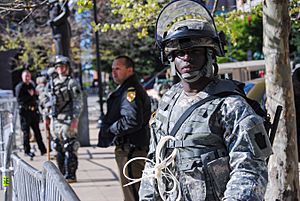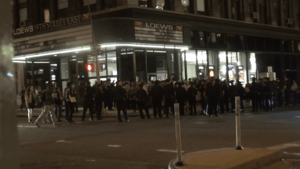2015 Baltimore protests facts for kids
Quick facts for kids 2015 Baltimore protests |
|||
|---|---|---|---|
| Part of the Black Lives Matter movement and reactions to the Death of Freddie Gray |
|||

Protesters demonstrating at the Baltimore Police Department's Western District building.
|
|||
| Date | April 18, 2015 – May 3, 2015 (17 days) | ||
| Location |
Baltimore, Maryland, U.S.
39°17′27″N 76°36′40″W / 39.290860°N 76.611024°W |
||
| Caused by | The hospitalization and death of Freddie Gray | ||
| Goals | Legal prosecution of those allegedly responsible for Gray's death; an end to police brutality. | ||
| Methods | Protests, rioting, arson, vandalism | ||
| Status | Ended, movement still active. | ||
| Parties to the civil conflict | |||
|
|||
| Lead figures | |||
|
|||
| Number | |||
|
|||
| Injuries and arrests | |||
| Injuries | 113 police officers injured, 2 people shot. | ||
| Arrested | 486 | ||
| Charged | Greg Bailey: charged with obstructing firefighting operations, malicious destruction of property and reckless endangerment. | ||
| State of emergency declared effective on April 27; rescinded May 6. A mandatory curfew was ordered beginning April 28 and ended May 3. |
|||
In April 2015, protests happened in Baltimore, Maryland. These protests followed the arrest and death of Freddie Gray, a 25-year-old African American man. Gray was injured while in police custody and later died. People protested because they wanted answers about what happened. They also wanted to stop police brutality. The protests included peaceful marches, but some turned violent. This led to property damage, fires, and many arrests.
Contents
- Understanding the Baltimore Protests
- Protests in Other Cities
- How People Reacted
- See also
Understanding the Baltimore Protests
Freddie Gray's Arrest and Injury
On April 12, 2015, police officers in Baltimore arrested Freddie Gray. He was 25 years old. Police said he had an illegal knife. However, later it was found that Gray was carrying a legal pocketknife. Gray was healthy when he was arrested.
While Gray was being taken in a police van, he got serious injuries to his neck and spine. He then went into a coma. The police department could not clearly explain how Gray got hurt. They also gave different information about what happened.
Protests Begin in Baltimore
After Gray's arrest, people started protesting. On April 18, hundreds of people gathered outside a police station. They protested how Gray was treated. Freddie Gray died on April 19, 2015. After his death, more protests happened.
The Baltimore Police Commissioner, Anthony Batts, shared his sadness with Gray's family. He also said "All Lives Matter." This was a response to the "Black Lives Matter" chant used by protesters. Protests continued for several nights. On April 21, the names of the six officers involved in Gray's arrest were shared. On April 24, groups like the ACLU and NAACP asked the Governor to act on police brutality.
When Protests Became Violent
On April 25, 2015, protests took place in downtown Baltimore. Many people marched peacefully. But after the official event, some people became violent. They damaged police cars and threw rocks at officers.
Near the baseball stadium, some groups broke store windows. They also fought with baseball fans. Because of the violence, fans at the game had to stay inside the stadium for safety. At least 34 people were arrested that day. Six police officers were hurt.
A photographer for a local newspaper was beaten by police. Another photographer was arrested. The mayor of Baltimore, Stephanie Rawlings-Blake, said most protesters were peaceful. She said a small group caused trouble. She later clarified her words. She meant that police tried to protect peaceful protesters. This meant that those who wanted to cause violence also had space to act.
- Documentaries
-
Voices Of The Freddie Gray Protest- Part 1.webm
Part 1 of a documentary video of the protests produced for WEAA during the day of April 25, before rioting started
-
Voices Of The Freddie Gray Protest- Part 2.webm
Part 2 of the WEAA documentary video
-
Baltimore- April 25th, 2015.webm
An independent documentary video of the protests during the day of April 25, before rioting started
Events on April 27
Freddie Gray's Funeral
Freddie Gray's funeral was held on April 27. Many people attended, including civil rights leaders and politicians. Gray was buried in Woodlawn Cemetery.
Preparing for More Unrest
A message spread on social media about a "purge" starting at 3 p.m. on April 27. This message caused concern. In response, a shopping mall called Mondawmin Mall closed early. Police in riot gear were sent to the area.
Police also shut down the nearby metro station. This made it hard for high school students to get home after school. Many students were stuck near the mall. Some eyewitnesses said police held students for a while before any trouble started. This made some students upset.
Other places also closed early that day. These included the University of Maryland Baltimore and the National Aquarium. A Baltimore Orioles baseball game was also postponed due to the unrest.
Violence Spreads
Around 75-100 people, who looked like high school students, started throwing things at police. This happened near Mondawmin Mall. The violence quickly spread. Two police cars were destroyed. Fifteen officers were injured.
A CVS Pharmacy was looted and burned. No one was hurt inside because employees had left. In another part of the city, a senior center under construction burned down. It was later rebuilt.
April 28: Cleanup and Curfew
Morning After the Riots
On the morning of April 28, firefighters put out fires. Residents started cleaning up the streets. Soldiers from the Maryland National Guard arrived to help. The mayor's office reported many vehicle and structural fires. Nearly 200 people were arrested.
Maryland Governor Larry Hogan moved his office to Baltimore. He visited damaged areas and thanked people for helping to clean up. A video of a mother, Toya Graham, scolding her son for throwing rocks went viral. She said she didn't want him to end up like Freddie Gray. Police Commissioner Anthony Batts praised her actions.

Afternoon and Evening
Hundreds of volunteers helped clean up the damaged areas. President Obama said there were too many problems between police and black citizens. But he also said there was "no excuse" for the violence. He said rioters were "stealing" and "destroying."
Mayor Stephanie Rawlings-Blake took back her comment calling rioters "thugs." She said her "anger interpreter" got the best of her. Religious leaders opened churches to give food to children.
A citywide curfew was set for 10:00 p.m. Police tried to tell everyone about the curfew. They used patrol cars, helicopters, and phone calls. After 10:00 p.m., police in riot gear moved crowds. They used pepper balls to disperse aggressive groups. By 11:00 p.m., the main intersection was clear. Ten people were arrested for violating the curfew or other actions.
After the Main Riots
Many small businesses struggled to reopen after the riots. Over 200 businesses were still closed by April 29. People of all ages and backgrounds helped clean up Baltimore's streets.
From April 29 to May 3, FBI aircraft recorded video of the unrest. This footage was later released. Many Korean American, Chinese American, and Arab American owned businesses were damaged.
The city's night curfew was lifted on May 3. Most charges against people for only breaking curfew were dropped. This was because it was found that only the governor could set a curfew, not the mayor. The Maryland National Guard left Baltimore on May 4.
Investigation and Charges
The Baltimore Police Department suspended six officers. This was done while they investigated Gray's death. The officers were Lieutenant Brian Rice, Sergeant Alicia White, Officer William Porter, Officer Garrett Miller, Officer Edward Nero, and Officer Caesar Goodson.
Police Commissioner Anthony Batts said officers failed to get Gray medical help quickly. He also said they did not follow rules by not buckling Gray in the van. The U.S. Department of Justice also started its own investigation.
Legal Outcomes for Officers
On May 1, 2015, prosecutors said they had reason to charge the six officers. This was after a medical report called Gray's death a "homicide." The prosecutor, Marilyn Mosby, said police acted illegally. She said Gray was hurt because he was handcuffed and unrestrained in the van. She also said Gray's arrest was not legal.
The trial for Officer William G. Porter ended without a decision. Officer Edward Nero was found not guilty of all charges on May 23, 2016. After this, charges against the remaining officers were dropped in July 2016.
Protests in Other Cities

On April 29, 2015, people protested in New York City. They blocked traffic to show support for Baltimore. More than 100 people were arrested.
Anti-police brutality protests also happened in Denver. Eleven people were arrested after fights broke out. Police used pepper spray on protesters. Protests also took place in other cities. These included Boston, Cincinnati, Minneapolis, and Washington, D.C..
How People Reacted
Government and Sports Actions
Baltimore's mayor announced a citywide curfew from 10:00 p.m. to 5:00 a.m. This started on April 28. Maryland Governor Larry Hogan declared a state of emergency. He also called in the Maryland National Guard. Up to 5,000 soldiers could be deployed.
Businesses complained that the curfew made them lose money. Mayor Rawlings-Blake said the curfew was needed to keep control. U.S. Attorney General Loretta Lynch asked for a civil rights investigation into Freddie Gray's case.
The Baltimore Ravens football team canceled their NFL Draft party. The Baltimore Orioles baseball team also postponed games. One game was even played without any fans. This was a very rare event in baseball history. The team also moved some games to another city.
Gang Involvement and Reactions
Baltimore police first said there was a threat of gang violence against officers. But later, leaders of some gangs, like the Bloods and Crips, denied this. They released a video asking for peaceful protest. They even worked with police and religious leaders to help enforce the curfew.
Sometimes, gang members helped prevent riots. They protected black-owned businesses and reporters. Other times, they directed rioters toward businesses owned by Korean, Chinese, and Arab Americans.
Leaders' Opinions
President Barack Obama strongly spoke against the violence. He said, "There's no excuse for the kind of violence that we saw yesterday." He added that looting and burning buildings were not protesting. He said they destroyed jobs and opportunities. Obama praised peaceful protesters. He asked the nation to work on solving poverty and police issues.
Some people criticized Mayor Rawlings-Blake and President Obama for calling rioters "thugs." The chief operating officer of the Baltimore Orioles, John P. Angelos, spoke about the protests. He said his main concern was not the property damage. Instead, he worried about how jobs had left cities. He also worried about civil rights being reduced.
Online Reactions
The protests were first talked about online using the hashtag #BaltimoreRiots. But later, #BaltimoreUprising became more popular. This change might have happened as the violence decreased. It also showed a new way of thinking about the events.
A digital archive was created to collect images and stories from the protests. It is called "Preserve the Baltimore Uprising."
Changes in Violence and Policing
Baltimore saw a big increase in homicides in May 2015. This was one of the deadliest months on record. There was also a drop in arrests. This happened after the six officers were charged in Gray's death.
Some residents said there was "no police" presence after the protests. One officer said they felt "confused and unsupported." The police union president said officers were "afraid of going to jail for doing their jobs properly."
See also
 In Spanish: Disturbios de Baltimore de 2015 para niños
In Spanish: Disturbios de Baltimore de 2015 para niños


